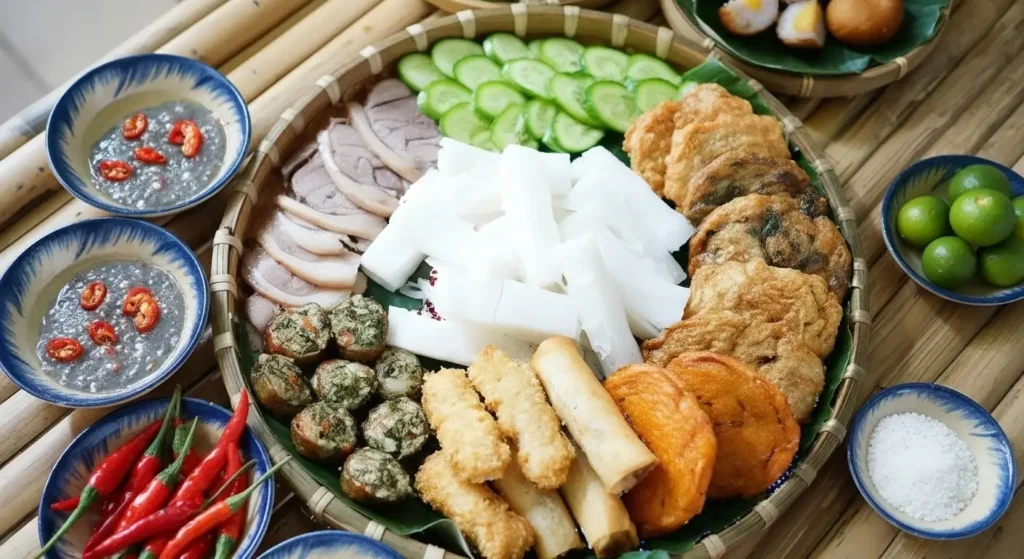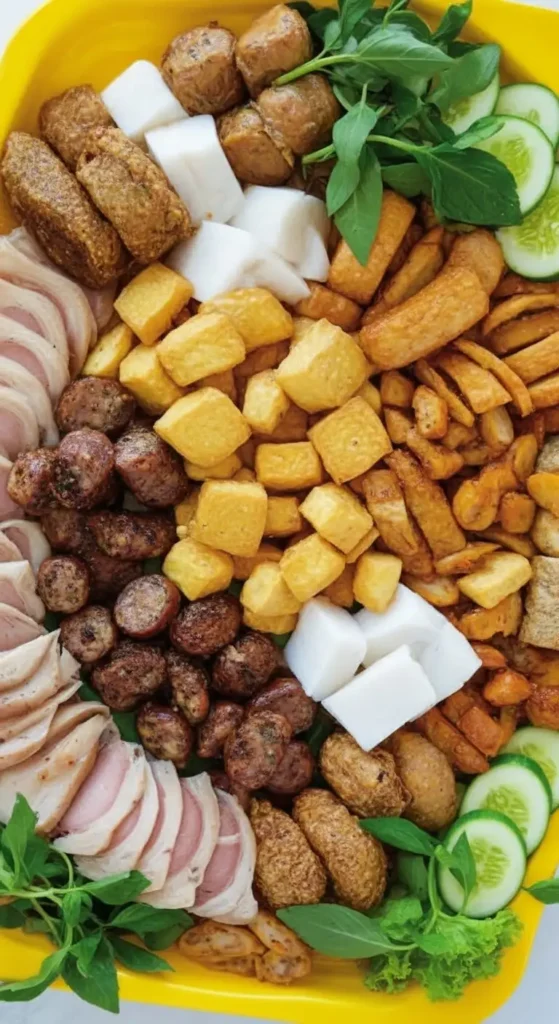Bún Đậu Mắm Tôm (pronounced boon dow mum tome) is a quintessential Vietnamese dish, celebrated for its perfect balance of textures and its notoriously pungent, yet addictive, dipping sauce. More than just a meal, it’s an iconic representation of Hanoi’s vibrant street food culture, served as a generous, colorful platter of simple yet satisfying ingredients.
The Basics of Bún Đậu Mắm Tôm
What is it?
The name breaks down into its three essential components:
Bún: Fresh, thin rice vermicelli noodles, often pressed into small, compact squares or cubes (bún lá).
Đậu: Golden, deep-fried fresh tofu, crispy on the outside and silky soft on the inside.
Mắm Tôm: Fermented shrimp paste, the dish’s signature, highly pungent, and intensely flavorful dipping sauce.
Origin and Culture:
Originating in Hanoi (Northern Vietnam), Bún Đậu Mắm Tôm was historically an affordable, rustic street snack. It is now a beloved dish found across the country, often served on a large, rustic platter or bamboo tray lined with banana leaves.
The “Smell Like Hell, Taste Like Heaven” Sauce:
- Mắm Tôm is what defines this dish. It has a strong, unique aroma that can be off-putting to first-timers. However, when properly prepared—mixed with kumquat juice (or lime), sugar, chili, and a drizzle of hot oil—it transforms into a rich, savory, slightly tangy, and deeply umami sauce that ties all the other mild ingredients together.

The Comprehensive Platter (Bún Đậu Mắm Tôm Toppings)
While the three titular ingredients are mandatory, a modern platter of Bún Đậu Mắm Tôm is an elaborate feast of complementary textures and flavors, often likened to a Vietnamese charcuterie board.
| Ingredient Category | Vietnamese Name | Description |
|---|---|---|
| The Essentials | Bún, Đậu, Mắm Tôm | Pressed vermicelli noodles, crispy tofu, and the pungent shrimp paste sauce. |
| Protein | Thịt Luộc (Boiled Pork) | Slices of boiled pork belly or pork shank, providing richness and chewiness. |
| Sausage/Loaf | Chả Cốm (Green Rice Flake Sausage) | A Northern specialty: pork paste mixed with green sticky rice flakes (cốm) then steamed or fried, offering a sweet, nutty flavor. |
| Dồi Sụn (Fried Pork Intestines) | Fried pork sausage/intestines stuffed with meat, herbs, and sometimes blood, offering a crunchy exterior and complex flavor. | |
| Rolls | Nem Rán / Chả Giò (Spring Rolls) | Crispy, fried spring rolls (North: Nem Rán, South: Chả Giò). |
| Freshness | Rau Thơm (Fresh Herbs) | A generous mix of fresh herbs like mint, basil, shiso leaves, and Vietnamese coriander, essential for cutting the richness. |
| Vegetables | Dưa Leo (Cucumber) | Slices of fresh cucumber for crunch and moisture. |
How to Eat Bún Đậu Mắm Tôm
Bún Đậu Mắm Tôm is an interactive, dip-and-eat meal. There is a specific order to preparing and consuming the dish for the best experience.
Customize the Mắm Tôm: This is the most crucial step. Start with a small amount of the raw shrimp paste.
Add Acid: Squeeze 1-2 kumquats (or a lime wedge) into the paste.
Add Heat & Sweetness: Add a teaspoon of sugar and a few slices of chili pepper.
Mix Vigorously: Stir the mixture quickly with chopsticks until it froths up and becomes foamy. This emulsification process mellows the raw funk and creates a perfect balance of salty, sweet, sour, and spicy.
Assemble and Dip: Use chopsticks to pick up a piece of the tofu or a square of the bún.
Dip and Enjoy: Dip your chosen ingredient directly into the customized Mắm Tôm sauce. The savory, intense paste is meant to fully coat the relatively bland noodles and tofu.
Incorporate Herbs: Between bites, chew on the fresh herbs. The mint and shiso act as a cleanser and a palate refresher, balancing the richness of the fried ingredients and the strength of the Mắm Tôm.
Beverage Pairing: The dish is traditionally served with a sour, palate-cleansing drink like iced kumquat tea (Trà Quất) or iced green tea, which helps neutralize the strong flavors and aroma.

4. Regional Differences in Bún Đậu Mắm Tôm
Bún Đậu Mắm Tôm is distinctly a Northern dish, but its popularity has led to its adoption across the country, with subtle regional adaptations, particularly concerning the essential Mắm Tôm sauce.
| Region | Primary Style and Characteristics | Key Differences |
|---|---|---|
| Northern Vietnam (Hanoi) | The Authentic Style. The dish maintains its traditional, rustic, and minimalist essence. The flavors are balanced, and the focus is on the quality of the primary ingredients. The Mắm Tôm is prepared to be very savory and salty, with less emphasis on sweetness. | The set is traditionally smaller and simpler. Favorite additions are the local specialties like Chả Cốm (green rice flake sausage) and Dồi Sụn (fried pork intestines). |
| Central Vietnam (Da Nang, Hue) | Balanced Adaptation. The Central region, known for its spiciness, readily adopted the dish. The overall composition remains true to the North, but sometimes local ingredients or herbs are introduced. | The Mắm Tôm sauce tends to be slightly more balanced in its saltiness, and you might find more chili added. There may also be local fried additions, but the core remains the same. |
| Southern Vietnam (Ho Chi Minh City) | Sweetened & Expanded. In the South, where the cuisine generally favors sweetness, the dish has been adapted for the local palate. Bún Đậu stalls in the South are famous for offering huge platters with a vast array of toppings. | The Mắm Tôm is usually prepared with more sugar to temper the saltiness and funk, making it more approachable for those new to the paste. The platters often include Southern-favorite additions like extra types of spring rolls or local sausages. |




